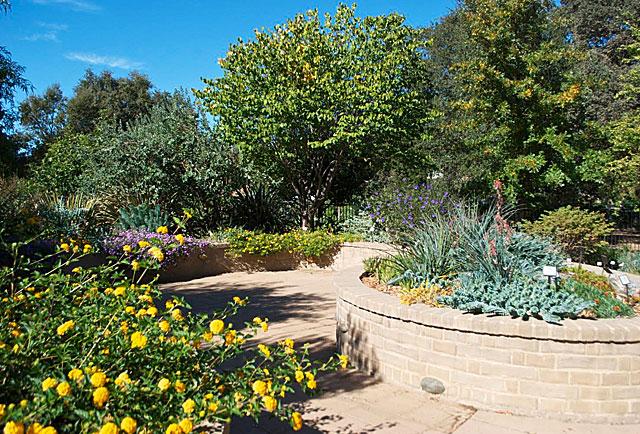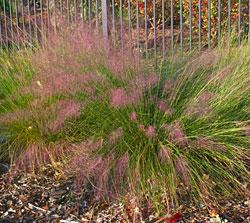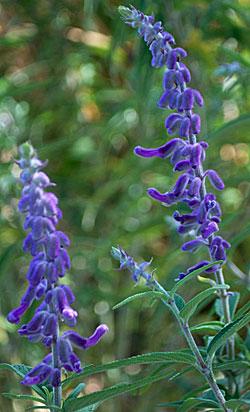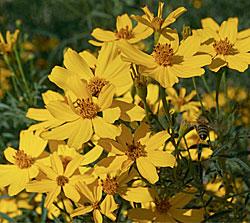Water-Efficient Landscape Gardens in October
Home » Fair Oaks Horticulture Center » WEL Gardens » October in the WEL
The WEL gardens at the Fair Oaks Horticulture Center are open to the public seven days a week from sunrise to sunset for self-guided tours.
Wheelchair accessible, the gardens feature natives, commonly available perennials, trees, shrubs, and plants from other Mediterranean climates that do well with less water during our long, hot, dry summers and tolerate our chilly, damp Sacramento County winters. Most plants are labeled and many are UC Davis Arboretum All-Stars. The landscape demonstrates how home gardeners can be smart about using the water we have to create beautiful landscapes. (For more information see Gardening with Limited Water.)

October is a lovely time to visit the garden. The low growing delicate white zephyr lilies have burst into bloom along the entrance walkways. Our native plants are waking up from their summer dormancy. The buckwheat, currant, Douglas iris and ceanothus etc., are sprouting fresh new growth. Guava, dwarf pomegranate, and dwarf strawberry tree (Arbutus unedo ‘Compacta’) fruits are ripening. Purple Mexican sage and red autumn sage flowers sharply accent the ripening, drying grasses. Frothy pink muhlygrass stalks glimmer in the parking lot bed. Shorter days have also triggered the daisy-like blooms covering the pungent yellow marigold shrub, copper canyon daisy. Bees continue to flit about the garden sampling late blooms. Scrub jays are happily planting acorns. Many deciduous shrubs and trees are turning lovely golden, scarlet and amber hues. Especially attractive are the Chinese pistache, burning bush, scarlet oak, trident maple and crape myrtles.
Fall is planting season in the Sacramento area. The pleasant fall weather allows roots to establish ahead of the rainy season. We will be replacing, removing, dividing and renovating areas of our garden throughout the month. Tasks include dividing overcrowded bulbs and perennials (especially our Peruvian scilla, daylillies, penstemons, and black eyed susans), deadheading late blooming salvias, cleaning out our dry river bed, and pulling late season weeds such as perennial spurge and pokeweed. For help identifying weeds check out the UC IPM online Weed Gallery.
Garden chores in October also include the time to continue to monitor for pests. Since pests tend to be specific to a plant it is important to identify the pest before determining a management plan. In many cases spraying a pest off the plant with water, picking it off and dropping it in a pail of sudsy water or deciding to live with the small amount of damage is the correct course of action. Often, the good bugs and birds are able to control minor infestations. In past years we have had our redbuds suffer damage by the redhumped caterpillar, Schizura concinna, which skeletonizes the outer leaves. It has been controlled in our garden by parasitic wasps that use the caterpillar as a host for their eggs. (A good resource for flower pest management and cultural care is the UC Integrated Pest Management website on flowers and for woody-plant leaf caterpillars is Leaf-feeding caterpillars on woody plants).
Irrigation lines, connectors and emitters will be checked for clogs, cuts and breaks regularly and schedules will be monitored. As the days shorten and cool off earlier, irrigation times will be reduced. (See more irrigation tips.)
Come check out the garden. In addition to the plants, pathways, patios, raised planters, drip irrigation, a dry creek bed and permeable pavement demonstrate water wise, sustainable alternatives for gardeners who are considering replacing or reducing their lawns. See Lawn Removal Methods for help with the first step.

|
Muhlenbergia capillaris For most of the year, this warm season mounding ornamental grass is just another evergreen background plant. But, in late summer and early fall just as other summer blooms fade, an otherwise nondescript evergreen grass takes center stage in the FOHC parking lot bursting with show stopping persistent, vibrant, gauzy, pinkish-red, waving panicles rising up to 2 feet above the thin dark green mounding leaves. It is guaranteed to grab attention as visitors enter the front gate. Muhlenbergia capillaris, pink muhly grass, is native to Mexico and the eastern United States. Thriving in sun to part shade, it copes well with our hot, dry climate with some summer water and good drainage. Growing to 2 feet by 2 feet prior to bloom the dark green, slender leaves make a good background for spring and early summer perennials and annuals. The long lasting blooms dry into a light buff color throughout winter until February when we prune the entire plant down to 4 to 6 inches just prior to new spring growth. (Additional information about this and other ornamental grasses seen in the WEL and elsewhere in Sacramento can be found here.) |

|
Salvia leucantha ‘Santa Barbara’ Also known as velvet sage, S. leucantha is a native of eastern and central Mexico. A moderate sized late summer/fall blooming perennial star in our far parking lot bed, it will bloom abundantly from late summer until the first frost especially if spent blossoms are removed just as they begin to fade. The size (2-1/2 feet tall and 4 feet wide) of our ’Santa Barbara’ cultivar is not as large as many other varieties. Very drought tolerant once established, the soft grayish green leaves set off brilliant purple flower stalks that make good cut and dried flowers. Plant in full sun, well drained soil and reduce summer watering for the best bloom. Mexican bush sage will die back to the ground in winter and may not survive a severe frost. If it does not die back during a mild winter, the plant should be cut close to the ground before spring growth begins to maintain a more compact shape and control flopping flower stems. |

|
Tagetes lemmonii 'Compactum' Also known as tangerine scented marigold, this large shrubby herbaceous perennial originates in canyons at elevations between 4,000 to 6,000 feet from southern Arizona throughout Mexico. A member of the sunflower family, it is covered in the fall with vibrant, yellow daisy-like flowers that attract bees and other pollinators. The very aromatic, airy foliage can cause dermatitis so care should be taken when pruning. We have 2 varieties in our garden, one that reaches 6 to 8 feet in height and a dwarf variety that grows to about 4 feet tall. Both can reach 4 to 6 feet in width. Copper canyon daisy prefers good drainage and is drought tolerant. In fact, it blooms more abundantly when not overwatered. Blooms are triggered by shorter days in fall, so an overcast period earlier in the year may produce some additional bloom. If overwatered or given too much shade, the plant may become leggy. Hedging back the stems may reduce subsequent flower production, however. Fall blooms cover the bush and last until frost. Plants will die back in winter under frost conditions. We have found that our plants do best when cut back close to the ground just as spring growth begins. |



